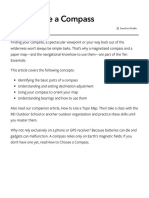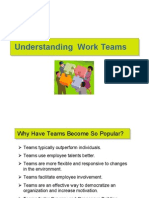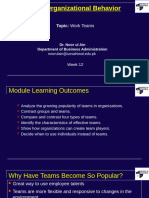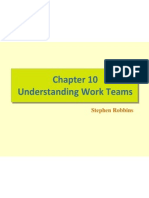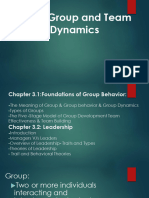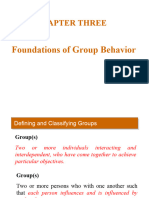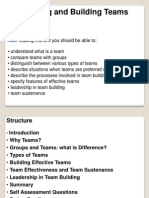0 ratings0% found this document useful (0 votes)
76 viewsChapter 10 TUT - Understanding Work Teams
Chapter 10 TUT - Understanding Work Teams
Uploaded by
busiThis chapter discusses work teams, including:
1) The differences between groups and teams, with teams requiring interdependence and able to achieve synergy.
2) Four types of teams - problem-solving, self-managed, cross-functional, and virtual teams.
3) The characteristics of effective teams, including contextual factors, composition, and processes like common goals and cohesion.
4) How to develop team players and when to use individuals instead of teams.
Copyright:
© All Rights Reserved
Available Formats
Download as PDF, TXT or read online from Scribd
Chapter 10 TUT - Understanding Work Teams
Chapter 10 TUT - Understanding Work Teams
Uploaded by
busi0 ratings0% found this document useful (0 votes)
76 views23 pagesThis chapter discusses work teams, including:
1) The differences between groups and teams, with teams requiring interdependence and able to achieve synergy.
2) Four types of teams - problem-solving, self-managed, cross-functional, and virtual teams.
3) The characteristics of effective teams, including contextual factors, composition, and processes like common goals and cohesion.
4) How to develop team players and when to use individuals instead of teams.
Original Description:
fif
Copyright
© © All Rights Reserved
Available Formats
PDF, TXT or read online from Scribd
Share this document
Did you find this document useful?
Is this content inappropriate?
This chapter discusses work teams, including:
1) The differences between groups and teams, with teams requiring interdependence and able to achieve synergy.
2) Four types of teams - problem-solving, self-managed, cross-functional, and virtual teams.
3) The characteristics of effective teams, including contextual factors, composition, and processes like common goals and cohesion.
4) How to develop team players and when to use individuals instead of teams.
Copyright:
© All Rights Reserved
Available Formats
Download as PDF, TXT or read online from Scribd
Download as pdf or txt
0 ratings0% found this document useful (0 votes)
76 views23 pagesChapter 10 TUT - Understanding Work Teams
Chapter 10 TUT - Understanding Work Teams
Uploaded by
busiThis chapter discusses work teams, including:
1) The differences between groups and teams, with teams requiring interdependence and able to achieve synergy.
2) Four types of teams - problem-solving, self-managed, cross-functional, and virtual teams.
3) The characteristics of effective teams, including contextual factors, composition, and processes like common goals and cohesion.
4) How to develop team players and when to use individuals instead of teams.
Copyright:
© All Rights Reserved
Available Formats
Download as PDF, TXT or read online from Scribd
Download as pdf or txt
You are on page 1of 23
1
CHAPTER 10
UNDERSTANDING WORK TEAMS
Dr Thuli Ngonyama-Ndou
TUT- Understanding Work Teams
2 Learning outcomes/objectives
Upon completion of this chapter students will be able to;
Analyse the growing popularity of using teams in
organisations.
Contrast groups and teams.
Compare and contrast four types of team arrangements.
Identify the characteristics of effective teams.
Show how organisations can create team players.
Decide when to use individuals instead of teams.
TUT- Understanding Work
Teams
3 Assessment criteria
Analyse the growing popularity of using teams in organisations.
Contrast groups and teams.
Compare and contrast four types of team arrangements.
Identify the characteristics of effective teams.
Show how organisations can create team players.
Decide when to use individuals instead of teams.
TUT- Understanding Work Teams
4 Introduction
A committed team can outperform individuals
Teams can sometimes achieve lot more that individuals could never
achieve
Teams are flexible and responsive to changing events than
traditional departments than other forms of permanent grouping
They can quickly assemble, deploy, refocus and disband
They are an effective means to democratize organizations and
increase employee involvement.
They introduce a collaborative mindset.
TUT- Understanding Work Teams
5 Our intelligence suggests that
“we all have a say”
TUT- Understanding Work Teams
6 Group vs Team
Group is a made up of two or more individuals interacting
interdependent who work together to achieve particular objectives.
Workgroup is a group that interacts primarily to share information
and to make decisions to help each group member perform within
his or her area of responsibility.
Workgroups do not necessarily need to engage on collective work
with joint effort
Group performance is a sum of individual’s contribution
No synergy, individuals do their own work with interaction and
dependency
TUT- Understanding Work Teams
7 Cont…
Work team is a group whose individual efforts result in performance
that is greater than the sum of individual inputs.
There is positive synergy through coordination
Both workgroup and workteam have some behavioural expectations
for members, collective normalisation efforts, active group dynamics
and some level of decision making
They both generate ideas, pool resources or coordinate logistics
such as work schedule although this information is limited to
information sharing and decision making outside the group.
However, these terms may be used interchangeable in different
contexts
TUT- Understanding Work Teams
8 Cont…
Why is work structured in teams?
Positive synergy that create increased performance
Creation of potential for organisation to generate greater
output without employing extra people
However, an effective team should possesses certain
characteristics which a group cannot posses
TUT- Understanding Work Teams
9 Contrast groups and teams.
TUT- Understanding Work Teams
10 Types of teams
Problem-solving teams – group of 5 to 12 employees from same department who
meet for few hours each week to discuss ways of improving quality, efficiency
and the work environment (recommend)
Self-managed teams – group of 10 to 15 people who take on responsibilities of
their former supervisor (take decisions)
Cross-functional teams – employees from about the same hierarchical level but
from different work areas who come together to accomplish a task (leadership
ambiguity, diversity, complexity, trust & teamwork, diverse skills)
Virtual teams – teams that use computer technology to tie together physically
dispersed members in order to achieve a common goal (trust, monitor progress,
publish effort & products)
Multiteam system – (team of teams) a collective of two or more interdependent
teams that share a superordinate goals, a team of teams (example of car
accident)
TUT- Understanding Work Teams
11 Types of teams
TUT- Understanding Work Teams
12 Characteristics of Effective Teams
Three categories;
Contextual influences that make team effective
Team’s composition
Team process that influence effectiveness
TUT- Understanding Work Teams
13 Characteristics of Effective Teams
TUT- Understanding Work Teams
14 Contextual factors
Four contextual factors that relate to team performance;
Adequate resources (support: timely information, proper
equipment, adequate staffing, encouragement, admin
assistance)
Leadership and structure (delegate responsibility, be
facilitator, ensure team cohesion)
Climate of trust (trust for the leader & other members,
commitment, no personal ownership of ideas)
Performance evaluation and rewards system (group based
appraisals, profit sharing, small group incentives to reinforce
team effort and commitment)
TUT- Understanding Work Teams
15 Team Composition
This indicate how team is staffed such as’
Abilities of the team members (knowledge, skills & abilities)
Personalities of the team members (personality influence team
performance, Big Five Personality (conscientiousness,
openness to experience, agreeableness, extravesion)
Allocation of roles – nine roles to be played – choose people
based on their preferences and skills
Diversity – other forms have no relation to team performance
(conflict & turnover) but education, expertise & proper
leadership have positive relationship
Cultural differences – good for tasks that require various
perspectives
Size of the team – small teams are more effective, about 5-9
members
Members preferences of team work – consider preferences
together with abilities, skills and personalities TUT- Understanding Work Teams
16 Team Composition
This indicate how team is staffed such as’
Abilities of the team members (knowledge, skills & abilities)
Personalities of the team members (personality influence team
performance, Big Five Personality (conscientiousness,
openness to experience, agreeableness, extravesion)
Allocation of roles – nine roles to be played – choose people
based on their preferences and skills
Diversity – other forms have no relation to team performance
(conflict & turnover) but education, expertise & proper
leadership have positive relationship
Cultural differences – good for tasks that require various
perspectives
Size of the team – small teams are more effective, about 5-9
members
Members preferences of team work – consider preferences
together with abilities, skills and personalities TUT- Understanding Work Teams
17 Roles of Teams
TUT- Understanding Work Teams
18 Team Process
Influenced by;
Common plan & purpose (good adjustable plan)
Specific goals (translate into good measurable and
realistic performance goals (SMART)
Team efficacy (confidence, capability)
Team identity (connection with the team - positive)
Team cohesion (attachment, closeness)
Mental model (beliefs about what and how work get
done)
Conflict level (incompatibility/dysfunctional & task conflict
functional
Social loafing (effort cannot de identified – members
should be individually & jointly accountable) TUT- Understanding Work
Teams
19 Turning individual into team players
Not everyone is a team player, e.g individualistic societies
How to turn individuals into team players?
Selection: hiring team players (traits, interpersonal skills)
Training: creating team players (workshops to improve
an array of skills such as problem solving,
communication negotiation)
Rewarding: providing incentives to be good team players
(reward system to encourage cooperative effort rather
than competitive one – promotions, pay raises and other
forms of recognition should be given to individuals who
work effectively as team members through training new
colleagues, sharing information, helping resolve team
conflict etc.)
TUT- Understanding Work Teams
20 When to use individuals instead of teams
Use of teams is costly
Benefits of using teams has to exceed the costs
Three tests ;
Can the work be done better by more than one person
(complexity & need for different perspectives)
Does the work create common purpose or set of goals for
the people in the group that is more than aggregate of
individual goals? (customer needs / customer service)
Work / task interdependency (success depends on
combination of expertise)
TUT- Understanding Work Teams
21 Summary
The chapter addressed the following;
Growing popularity of using teams in organisations
Groups and teams
Four types of team arrangements
Characteristics of effective teams
Creating team players
Using individuals instead of teams
TUT- Understanding Work Teams
22
End!!!!!!
THANK YOU
TUT- Understanding Work Teams
23
TUT- Understanding Work Teams
You might also like
- 4MA1 2HR Rms 20180822Document19 pages4MA1 2HR Rms 20180822Annie SinsenNo ratings yet
- Course Syllabus - English 102Document9 pagesCourse Syllabus - English 102api-311872487No ratings yet
- How To Use A CompassDocument10 pagesHow To Use A CompassShaun JohnsonNo ratings yet
- OB - Summary Note - Ch10Document3 pagesOB - Summary Note - Ch10huynhhuongthuy2508No ratings yet
- Understanding Work TeamsDocument7 pagesUnderstanding Work TeamsSadia RasoolNo ratings yet
- HBO Chapter 10Document5 pagesHBO Chapter 10Leira VibarNo ratings yet
- Organizational Behavior: Understanding Work TeamsDocument19 pagesOrganizational Behavior: Understanding Work TeamsdewpraNo ratings yet
- Chapter 10 Understanding Work TeamsDocument2 pagesChapter 10 Understanding Work TeamsHazel Adelan MugaNo ratings yet
- Project BST (Autosaved) (Autosaved) 7777777Document18 pagesProject BST (Autosaved) (Autosaved) 7777777ghettoNo ratings yet
- Organization Behavior PresentationDocument14 pagesOrganization Behavior Presentationcool19890529No ratings yet
- Chapter 05 Understanding Work TeamsDocument21 pagesChapter 05 Understanding Work TeamsalaaNo ratings yet
- Answer Each Question by Entering The Number Below That Best Describes Your Current TeamDocument8 pagesAnswer Each Question by Entering The Number Below That Best Describes Your Current TeamRashid AliNo ratings yet
- Understanding Work GroupsDocument22 pagesUnderstanding Work GroupsEmma QuennNo ratings yet
- Chapter 10Document18 pagesChapter 10Gautham RajeshwaranNo ratings yet
- Status of Teans in Indian Organ Is at IonsDocument20 pagesStatus of Teans in Indian Organ Is at Ionssamim_sarkarNo ratings yet
- Understanding Work TeamsDocument52 pagesUnderstanding Work TeamsJulia DanielNo ratings yet
- Unit 2Document55 pagesUnit 2mendi boipeloNo ratings yet
- Module 11Document25 pagesModule 11Juvie Gagasa MarianoNo ratings yet
- Organizational BehaviourDocument21 pagesOrganizational Behaviour2021-ba-6325No ratings yet
- A Presentation OnDocument30 pagesA Presentation OnSHIVANGI1JAINNo ratings yet
- Updated Team and Team WorkDocument29 pagesUpdated Team and Team Workabdulwahab harunaNo ratings yet
- Organizational Behaviour Teams (Robbins)Document16 pagesOrganizational Behaviour Teams (Robbins)Rushabh Vora100% (3)
- Chapter 9 April 2006Document9 pagesChapter 9 April 2006Anna MahmudNo ratings yet
- Teamwork - PPT 2018 - 19Document59 pagesTeamwork - PPT 2018 - 19Deeksha SinghNo ratings yet
- Team T-Together E-Everyone A-Achieves M-MoreDocument14 pagesTeam T-Together E-Everyone A-Achieves M-MorePranjal Jaiswal100% (1)
- Organizational Behavior: Chapter 6: Understanding Work TeamDocument6 pagesOrganizational Behavior: Chapter 6: Understanding Work TeamCatherineNo ratings yet
- Hercher Poly Technic Tvet College: Occupationstandard: - Vehicle Servicing SectorDocument24 pagesHercher Poly Technic Tvet College: Occupationstandard: - Vehicle Servicing Sectorabdumusa593No ratings yet
- Updated Team and Team WorkDocument30 pagesUpdated Team and Team WorkGanesh MuruganNo ratings yet
- Teams ManagementDocument16 pagesTeams ManagementKrishna KumarNo ratings yet
- ACCTG ELEC 1 Module 10Document16 pagesACCTG ELEC 1 Module 10Trayle HeartNo ratings yet
- Week 4 Team Work and Group WorkDocument25 pagesWeek 4 Team Work and Group WorkIodanutzs UkNo ratings yet
- Understanding Work TeamsDocument15 pagesUnderstanding Work TeamsAmeshNo ratings yet
- Ob Unit 3Document28 pagesOb Unit 3Riya SharmaNo ratings yet
- TOM - Tambahan Laili RDocument12 pagesTOM - Tambahan Laili RsepnidermaNo ratings yet
- Teams: Presented By: Pranay Vij. It AndtelecomDocument19 pagesTeams: Presented By: Pranay Vij. It AndtelecomMayank MittalNo ratings yet
- Chapter 3 OBDocument35 pagesChapter 3 OBtmuse474No ratings yet
- Problem Solving TeamsDocument3 pagesProblem Solving TeamsUbaidNo ratings yet
- Ob DoxDocument10 pagesOb Doxshahraiz aliNo ratings yet
- Unit 9 - SubmissionDocument19 pagesUnit 9 - SubmissioncapitallsolutionsNo ratings yet
- Overview of OB For Work in TeamsDocument14 pagesOverview of OB For Work in TeamsSaif HassanNo ratings yet
- Chapter 10 Understanding Work Teams HBODocument6 pagesChapter 10 Understanding Work Teams HBONoceja, Mark Allen L.No ratings yet
- Session 2 - NotesDocument11 pagesSession 2 - Notesclaire.horswill2No ratings yet
- From Groups To TeamsDocument17 pagesFrom Groups To TeamsLeoreyn Faye MedinaNo ratings yet
- Team ToolkitDocument17 pagesTeam ToolkitCOT Management Training Insitute100% (1)
- Team Importance & Management: Presentation By: Deepthi. P Jinesh Jain Gheerdhardhini. M Bindu Thushara. NDocument14 pagesTeam Importance & Management: Presentation By: Deepthi. P Jinesh Jain Gheerdhardhini. M Bindu Thushara. NNB Thushara HarithasNo ratings yet
- Team Work Week 1-2Document5 pagesTeam Work Week 1-2Cueto, Trisha Almae D.No ratings yet
- Team ManagementDocument39 pagesTeam ManagementSANJAYSINH PARMAR100% (1)
- Understanding Work TeamsDocument17 pagesUnderstanding Work TeamsLê Viết Thảo NguyênNo ratings yet
- Chapter-10 HBODocument5 pagesChapter-10 HBOKert SilvaNo ratings yet
- Chapter 13 Teams and Teambuilding Part 1Document11 pagesChapter 13 Teams and Teambuilding Part 1Natalie Rose Ona-PunzalanNo ratings yet
- Updated Team and Team WorkDocument30 pagesUpdated Team and Team WorkAditya BaglaNo ratings yet
- Software Project Management Risk ManagementDocument7 pagesSoftware Project Management Risk Managementsibhat mequanintNo ratings yet
- Chapter 9 - Teams: Why Have Teams Become So Popular?Document4 pagesChapter 9 - Teams: Why Have Teams Become So Popular?Pure_Oxygen12No ratings yet
- Teamwork and LeadershipDocument31 pagesTeamwork and LeadershipFrank Korang-DanquahNo ratings yet
- Book Slides - Chapter 10 - Understanding Work TeamsDocument19 pagesBook Slides - Chapter 10 - Understanding Work TeamsKiran KhemkaNo ratings yet
- # 00 Team Effectiveness PDFDocument58 pages# 00 Team Effectiveness PDFFakhrul RoziNo ratings yet
- (G. Moorhead and R.W. Griffin) : O B U W TDocument4 pages(G. Moorhead and R.W. Griffin) : O B U W TAltaf HussainNo ratings yet
- Module1 Team BuildingDocument74 pagesModule1 Team BuildingTanu Jain100% (2)
- BUS 5113 - Unit - 6 - The Art of Working With Teams - DA1Document9 pagesBUS 5113 - Unit - 6 - The Art of Working With Teams - DA1NaderYasenHNo ratings yet
- Teamworka Key To Organizational SuccessDocument3 pagesTeamworka Key To Organizational SuccessazharmateNo ratings yet
- Concept of TeamsDocument14 pagesConcept of TeamsTindu Surendran100% (1)
- Leading Teams: Expert Solutions to Everyday ChallengesFrom EverandLeading Teams: Expert Solutions to Everyday ChallengesRating: 2 out of 5 stars2/5 (1)
- Maxipro Double Offset Butterfly Valve Nov 2009 LRDocument6 pagesMaxipro Double Offset Butterfly Valve Nov 2009 LRLungisaniNo ratings yet
- Upskill Cs Boeing 1117Document2 pagesUpskill Cs Boeing 1117pierocarnelociNo ratings yet
- UML For Non Functional ReqsDocument114 pagesUML For Non Functional Reqsmrgirish100% (1)
- Contact Force - WikipediaDocument2 pagesContact Force - WikipediaM. Darius LagascaNo ratings yet
- Katalog AC Fujitsu R22 PDFDocument42 pagesKatalog AC Fujitsu R22 PDFriskiriskNo ratings yet
- Sin TítuloDocument1 pageSin TítuloyesopunkNo ratings yet
- Servicenow Technical Training Catalog: Website NowDocument2 pagesServicenow Technical Training Catalog: Website Nowcamis_vieiraNo ratings yet
- Intl. J. Phys. Beh. Res. Vol. 25 240 249 2013Document11 pagesIntl. J. Phys. Beh. Res. Vol. 25 240 249 2013Stena NadishaniNo ratings yet
- Bill of MaterialDocument4 pagesBill of MaterialsundyaNo ratings yet
- API STD 1104Document45 pagesAPI STD 1104Andreia MenesesNo ratings yet
- Mind Over Matter: Evidence That Consciousness Is Connected To, and Affects The Physical World Around UsDocument25 pagesMind Over Matter: Evidence That Consciousness Is Connected To, and Affects The Physical World Around UsKosta Kourabis100% (1)
- IS F WiringDocument29 pagesIS F WiringbenzcobraNo ratings yet
- Etika Bisnis2Document143 pagesEtika Bisnis2ElqueeenNo ratings yet
- Professional Practice 1Document5 pagesProfessional Practice 1Niño OpulenciaNo ratings yet
- TSL 5345 M&M Graph Lesson PlanDocument2 pagesTSL 5345 M&M Graph Lesson Planddougl18100% (1)
- Days & Months BingoDocument17 pagesDays & Months BingoPau LKNo ratings yet
- Jatoba, M., Gutierriz, I., Fernandes, P. O., Teixeira, J. P., & Moscon, D. (2019)Document9 pagesJatoba, M., Gutierriz, I., Fernandes, P. O., Teixeira, J. P., & Moscon, D. (2019)Uni KartikasariNo ratings yet
- Liquidation ReportDocument3 pagesLiquidation Reportkabataansulong2023No ratings yet
- Piecewise Linear Regression Examples (Lesson 1) TruncatedDocument4 pagesPiecewise Linear Regression Examples (Lesson 1) TruncatedStanley YongNo ratings yet
- Binary Representation - Year 7Document2 pagesBinary Representation - Year 7Orlan LumanogNo ratings yet
- Drug WarDocument288 pagesDrug WarMich GuarinoNo ratings yet
- Keiths Resume 2 1Document2 pagesKeiths Resume 2 1api-686105315No ratings yet
- Mk8-MM-Manual-19.05.2020 - ENG - 159-237Document79 pagesMk8-MM-Manual-19.05.2020 - ENG - 159-237Eduardo JoseNo ratings yet
- 8021 Int OTG MS P1Document16 pages8021 Int OTG MS P1Selina AvianaNo ratings yet
- Marine Mammal Stranding Response Manual 2nd EdDocument141 pagesMarine Mammal Stranding Response Manual 2nd EdLokal Lab OngroundNo ratings yet
- Floor Gully 1Document93 pagesFloor Gully 1Khaled GameaNo ratings yet
- Environmental Assessment of The Hot-Dip Galvanization ProcessesDocument3 pagesEnvironmental Assessment of The Hot-Dip Galvanization ProcessesArshath FleminNo ratings yet


